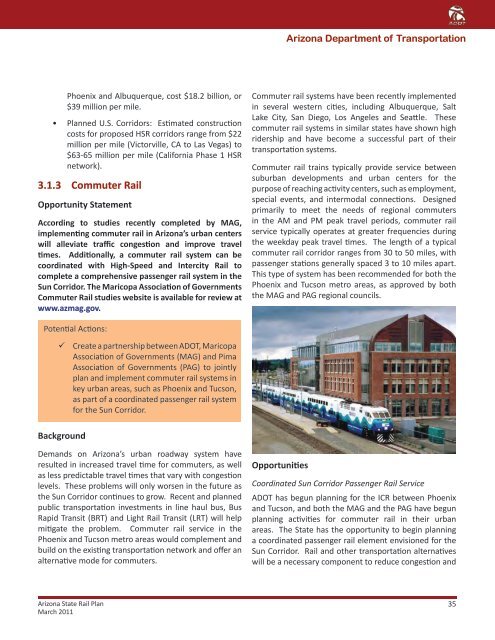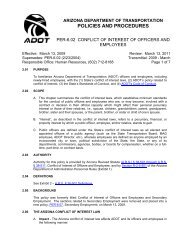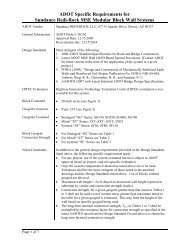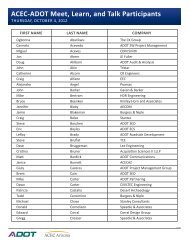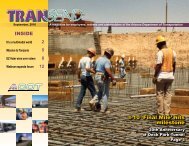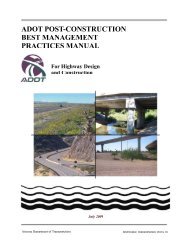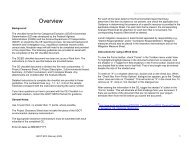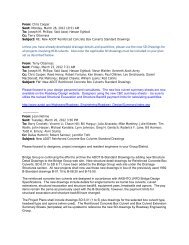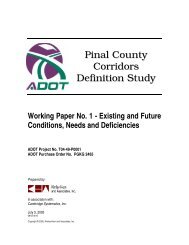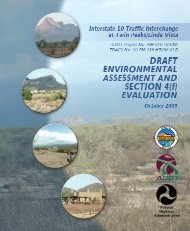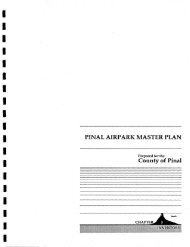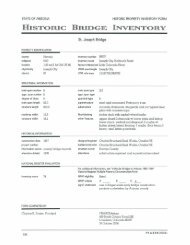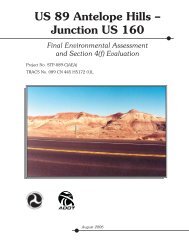2011 Arizona State Rail Plan - Arizona Department of Transportation
2011 Arizona State Rail Plan - Arizona Department of Transportation
2011 Arizona State Rail Plan - Arizona Department of Transportation
Create successful ePaper yourself
Turn your PDF publications into a flip-book with our unique Google optimized e-Paper software.
Phoenix and Albuquerque, cost $18.2 billion, or<br />
$39 million per mile.<br />
• <strong>Plan</strong>ned U.S. Corridors: Estimated construction<br />
costs for proposed HSR corridors range from $22<br />
million per mile (Victorville, CA to Las Vegas) to<br />
$63-65 million per mile (California Phase 1 HSR<br />
network).<br />
3.1.3 Commuter <strong>Rail</strong><br />
Opportunity <strong>State</strong>ment<br />
According to studies recently completed by MAG,<br />
implementing commuter rail in <strong>Arizona</strong>’s urban centers<br />
will alleviate traffic congestion and improve travel<br />
times. Additionally, a commuter rail system can be<br />
coordinated with High-Speed and Intercity <strong>Rail</strong> to<br />
complete a comprehensive passenger rail system in the<br />
Sun Corridor. The Maricopa Association <strong>of</strong> Governments<br />
Commuter <strong>Rail</strong> studies website is available for review at<br />
www.azmag.gov.<br />
Potential Actions:<br />
9 Create a partnership between ADOT, Maricopa<br />
Association <strong>of</strong> Governments (MAG) and Pima<br />
Association <strong>of</strong> Governments (PAG) to jointly<br />
plan and implement commuter rail systems in<br />
key urban areas, such as Phoenix and Tucson,<br />
as part <strong>of</strong> a coordinated passenger rail system<br />
for the Sun Corridor.<br />
Background<br />
Demands on <strong>Arizona</strong>’s urban roadway system have<br />
resulted in increased travel time for commuters, as well<br />
as less predictable travel times that vary with congestion<br />
levels. These problems will only worsen in the future as<br />
the Sun Corridor continues to grow. Recent and planned<br />
public transportation investments in line haul bus, Bus<br />
Rapid Transit (BRT) and Light <strong>Rail</strong> Transit (LRT) will help<br />
mitigate the problem. Commuter rail service in the<br />
Phoenix and Tucson metro areas would complement and<br />
build on the existing transportation network and <strong>of</strong>fer an<br />
alternative mode for commuters.<br />
<strong>Arizona</strong> <strong>State</strong> <strong>Rail</strong> <strong>Plan</strong><br />
March <strong>2011</strong><br />
Commuter rail systems have been recently implemented<br />
in several western cities, including Albuquerque, Salt<br />
Lake City, San Diego, Los Angeles and Seattle. These<br />
commuter rail systems in similar states have shown high<br />
ridership and have become a successful part <strong>of</strong> their<br />
transportation systems.<br />
Commuter rail trains typically provide service between<br />
suburban developments and urban centers for the<br />
purpose <strong>of</strong> reaching activity centers, such as employment,<br />
special events, and intermodal connections. Designed<br />
primarily to meet the needs <strong>of</strong> regional commuters<br />
in the AM and PM peak travel periods, commuter rail<br />
service typically operates at greater frequencies during<br />
the weekday peak travel times. The length <strong>of</strong> a typical<br />
commuter rail corridor ranges from 30 to 50 miles, with<br />
passenger stations generally spaced 3 to 10 miles apart.<br />
This type <strong>of</strong> system has been recommended for both the<br />
Phoenix and Tucson metro areas, as approved by both<br />
the MAG and PAG regional councils.<br />
Opportunities<br />
<strong>Arizona</strong> <strong>Department</strong> <strong>of</strong> <strong>Transportation</strong><br />
Coordinated Sun Corridor Passenger <strong>Rail</strong> Service<br />
ADOT has begun planning for the ICR between Phoenix<br />
and Tucson, and both the MAG and the PAG have begun<br />
planning activities for commuter rail in their urban<br />
areas. The <strong>State</strong> has the opportunity to begin planning<br />
a coordinated passenger rail element envisioned for the<br />
Sun Corridor. <strong>Rail</strong> and other transportation alternatives<br />
will be a necessary component to reduce congestion and<br />
35


